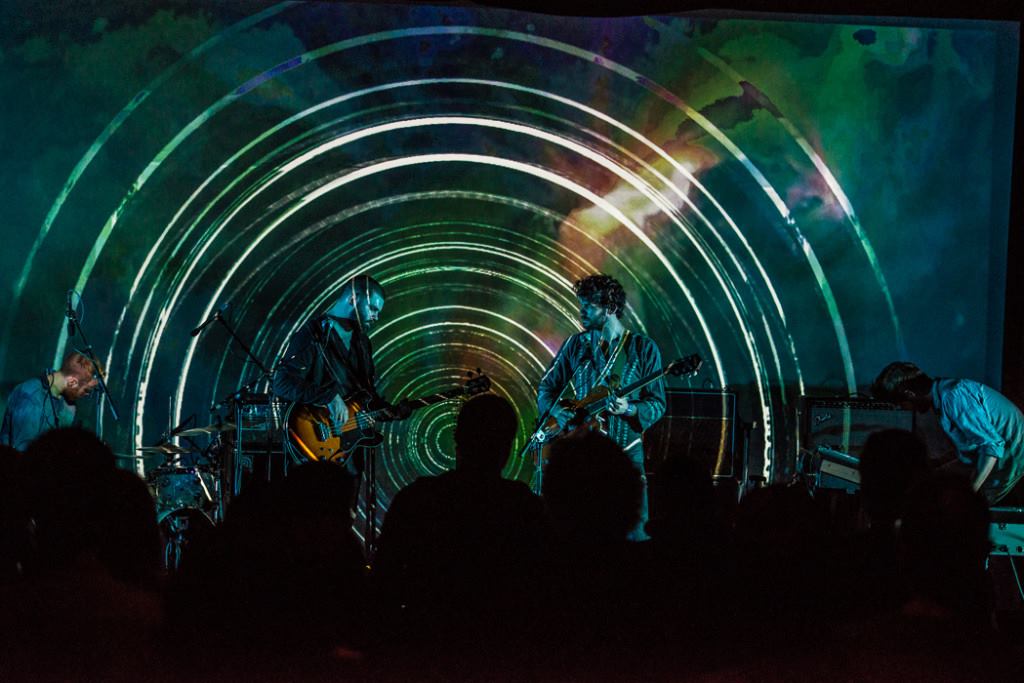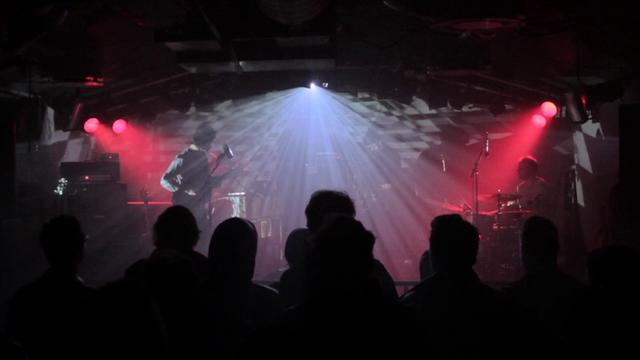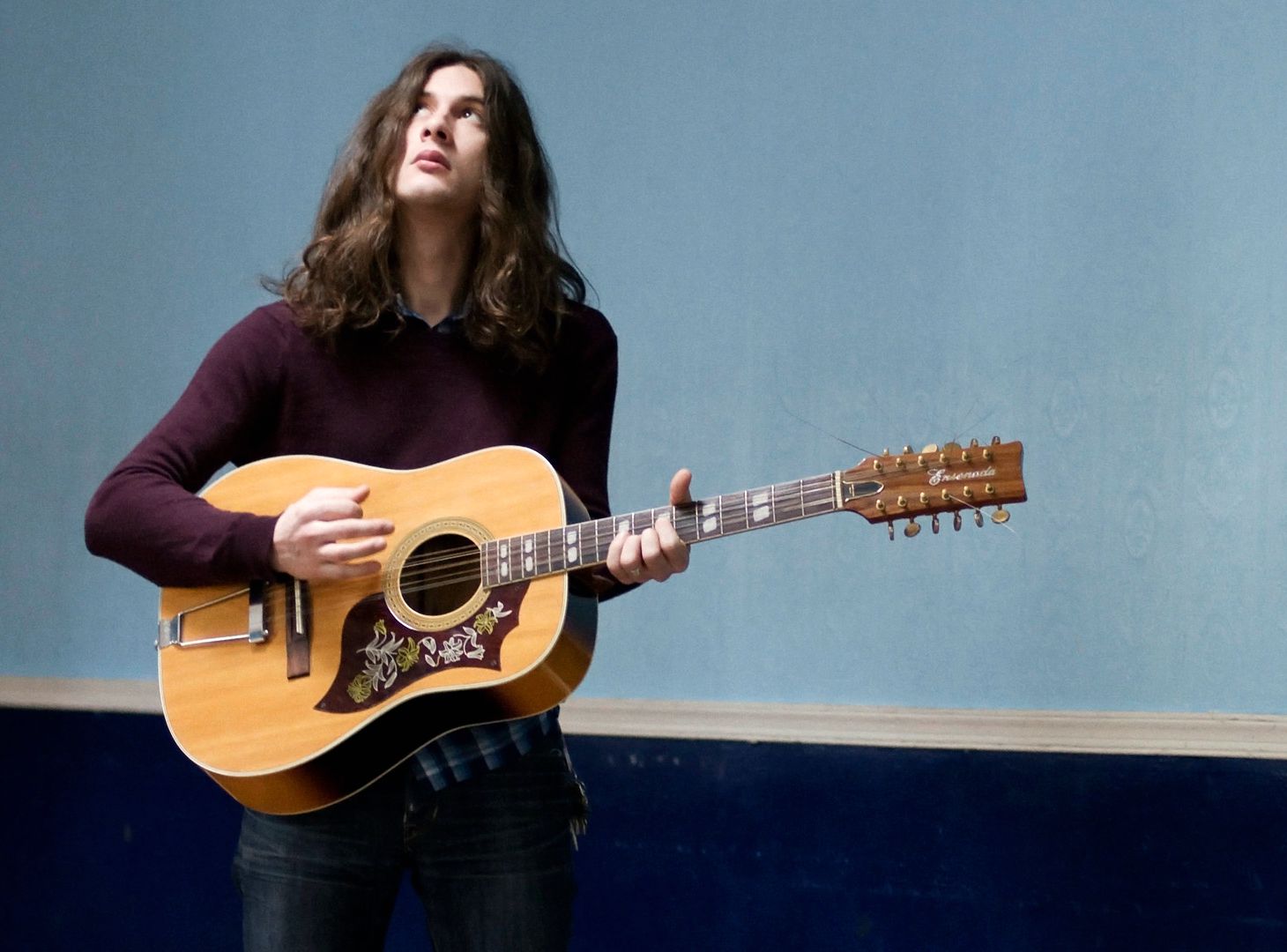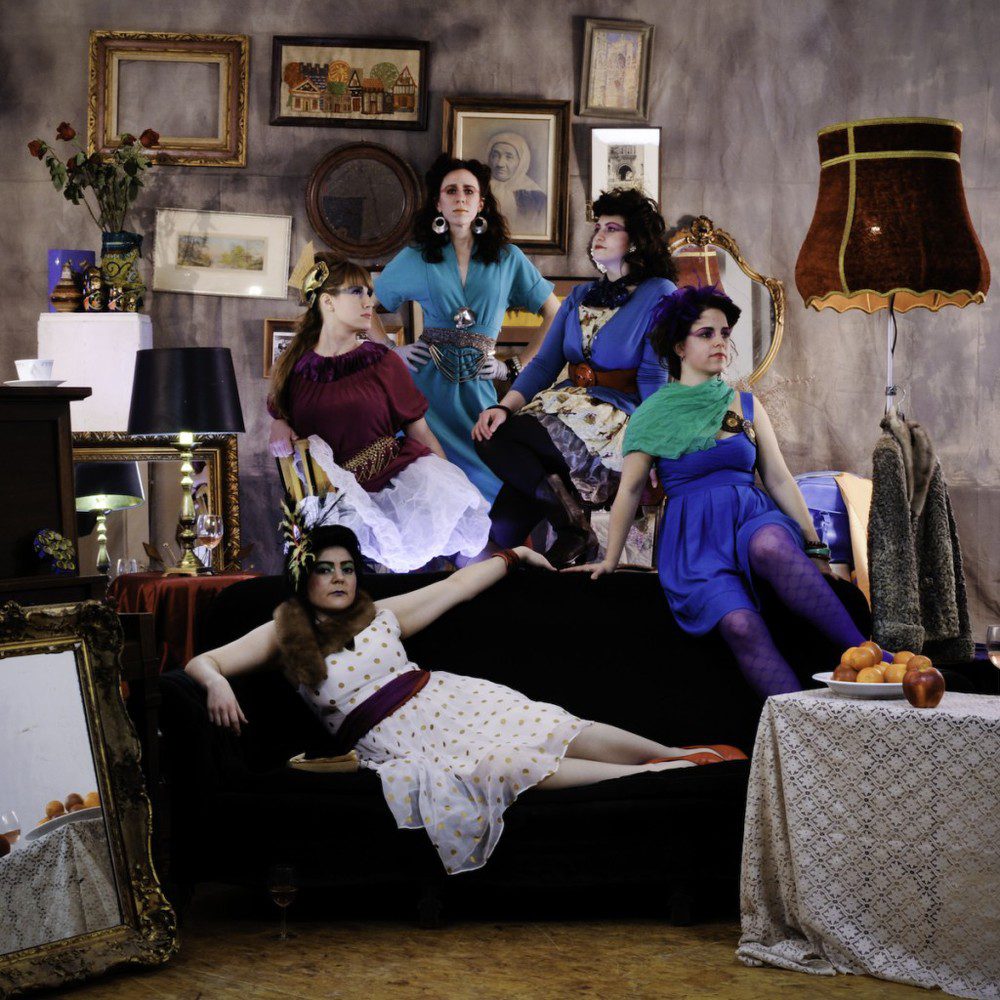
Electric Eye‘s debut collection Pick-up, Lift-off, Space, Time came out last spring, but three of the group’s four members have been playing together for a decade and a half, since they were in high school in a small city on the west coast of Norway. Even then, guitarist and vocalist Øystein Braut (also of The Alexandria Quartet) loved the grooves and repetitions of psychedelic drone music. In 2012, the band of four–each already established in the Norwegian music scene–officially solidified into Electric Eye and began working on their self-produced first LP.
The record spans a broad range of influences, channeling a groovy, plodding twelve-bar blues on one track and shimmering over Indian seven-note scales on the next. Each song takes its time to develop, growing into a multi-textured soundscape with layers of distortion, synth and long jams that could be a soundtrack to a movie, or a trip into outer space. Though Electric Eye embraces the expansive power of repetition, each instrumental line develops its own set of twists and turns, recalling the psychedelic sounds of seventies drone rock while also rolling a catchy array of pop hooks and bluesy rhythms into the mix.
In between a Portugal tour, Oslo Psych Fest, and coming to Austin to play SXSW this March, Øystein Braut was kind enough to chat with Audiofemme about drone grooves, the psych scene in Norway, and the influences that contributed to Pick-up, Lift-off, Space, Time.
AF: You’ve toured a lot in the past few months, including a trip to Portugal. How have your travels been?
ØB: I’d never been to Portugal before, so that was really cool. It was in the late fall and the weather was getting cold in Norway, so it was nice to head down there and enjoy the nicer weather for a while. We played seven shows, I think. The crowd was amazing. Most of the shows we played by ourselves, without any other band. We had some local support in a few places, but basically we did our own tour.
AF: You also came back to Norway to play Oslo Psych Fest.
ØB: I’m involved in setting up that festival as well–just trying to build a psych scene in Norway. We’re taking the model from the Austin Psych Fest, which I went to last year. [fusion_builder_container hundred_percent=”yes” overflow=”visible”][fusion_builder_row][fusion_builder_column type=”1_1″ background_position=”left top” background_color=”” border_size=”” border_color=”” border_style=”solid” spacing=”yes” background_image=”” background_repeat=”no-repeat” padding=”” margin_top=”0px” margin_bottom=”0px” class=”” id=”” animation_type=”” animation_speed=”0.3″ animation_direction=”left” hide_on_mobile=”no” center_content=”no” min_height=”none”][Oslo Psych Fest] was a great weekend, and hopefully it will become bigger in the future. We played with ten other bands. We had Wolf People and The Rolydrug Couple, from Chile, and Disappears played just after us.
AF: What’s the psych scene like in Norway? Is it getting big?
ØB: I mean, Norway is a pretty small country, so everything is relatively small here. For the festival we had maybe two hundred people each day. That’s why we keep trying to get abroad as much as we can. Norway only has about five million people, so we have two or three cities that we call major cities, which are small cities by US standards I guess. It’s easier to go to the UK or Germany or the rest of Scandinavia, maybe the US.
AF: How did Electric Eye come together?
ØB: All of us except the drummer went to high school together in a small city called Haugesund on the west coast of Norway. We started playing together about fifteen years ago, and just kept playing over the years. Two years ago, we all started working on this project, which felt very natural since we’d been playing together all this time. With a new name and new songs, we had a new band. We started in 2012 with some gigs, and then we recorded an album. It’s gone really well so far.
AF: The four of you have played not only in different bands, but in different genres. How did you settle on the music you currently play?
ØB: I’ve always been really into psych stuff, but never had a band that did it. I had a lot of songs that were meant to be really long, and more psychedelic, experimental, whatever you call it. In the music scene in Norway, if you need someone to play bass on your songs, you just call them and ask them. It’s not really separated by genre. Of course there are some separations between black metal guys and pop guys. But the scene is really small and not that separated. We’re all musicians. For me, it’s not that different playing different genres, as long as it’s cool music.
AF: What was it like recording your debut, Pick-up, Lift-off, Space, Time?
ØB: We did it ourselves in our rehearsal room in the summer of 2012. We recorded the drum groove, which are sort of monotonous, and just started layering stuff on top of it. We really like to have a pop hook in there somewhere, even if it’s kind of got a jam sound. We worked on the album a lot during the fall of 2012. We produced all of it ourselves, because we kind of had an idea where we were going with it and knew how it was supposed to sound. It didn’t really make sense to bring in some producer, because we had a good idea of what we wanted it to sound like. So we just did it ourselves.
AF: What’s the significance of the album’s title?
ØB: It’s the first four songs of a Swedish album from the sixties, by a band called Hansson & Karlsson, and the album is called “Man At The Moon.” It uses, like…drums and organs, only. I love that album, and I thought it would bring some nice images to mind. I liked having a long title, as well. It sounded cool, I guess. There’s no hidden meaning. It sounds like a countdown for a space shuttle taking off.
AF: Is there a philosophy behind the instrumental, soundscape-like quality of the album?
ØB: I think we just decided to not be in a hurry with the songs, and not to feel like we had to be in a hurry to get to the chorus. We gave the grooves time to develop. It could be a soundtrack for a movie or something. And whenever we play live, as often as we can we use some visual projections, which seems to work really well with the music.
AF: You’ve mentioned you draw inspiration from India. Tell us how that factors in.
ØB: I went to India the year before we started this project. I’ve always been interested in classical Indian music. We use those types of scales, and some Indian instruments. Something called a drone box? Whenever we play concerts and we have it, it plays one really ambient, background chord. Compared to Western music, Indian music allows stuff to last a little bit longer. It’s more hypnotic. Some songs can last for twenty minutes and that’s not weird, that’s just how long the pieces have to be. That’s also the philosophy for our album. We don’t have any twenty minute songs, but we believe in letting the songs evolve to however long they’re supposed to be.
AF: It must be liberating to decide that you’re not going to pay as much attention to typical song structure.
ØB: We have short songs, but it’s kind of nice to have more space, compared to contemporary popular music, and not be stopped by the four minute limit. I mean, there’s a lot of stuff from contemporary, regular music that’s great. We use chorus and verse structure, but we don’t feel trapped by it. And when we play live, we try to let the song be a starting point and then improvise. It’s really important to try to keep it interesting, of course, and not to lose the hooks of the songs. The easiest thing is just to put on a lot of noise for twenty minutes, without any stuff going on in it. But to do it for twenty minutes and keep it interesting…
AF: There are also a couple of tracks (6 AM, The Road) that feel so bluesy. Is the blues big in Norway? Where does that aspect come from?
ØB: I always loved the blues. Some of the older blues has a lot of the same stuff we like to work with: groove, minor changes, being repeated over and over. That’s kind of what we’re doing as well. Here in Norway, older people listen to the blues more than younger people do. But it’s kind of the basis for all rock and roll.
AF: Do you incorporate traditional Norwegian folk music into your playing?
ØB: No, not really. Norwegian folk music is more dance music. It’s similar to Irish or Celtic music. They have some scales and stuff that we use, but I’m not really interested. I haven’t listened to all that much of it, actually. American pop music is more exotic, or exciting, for me.
AF: You’re coming to America in March, to play SXSW in Austin. We’re so excited to have you over!
ØB: We’re super excited. This is our first trip over. I’ve been to the US before, to Austin Psych Fest, but never played there. I have friends who say that SXSW is crazy, super crowded, super colorful. That’ll be cool. And then we’re going to start recording pretty soon, and hopefully get back to the US, and then get picked up by some huge record label–haha. I don’t know. We really just want to keep on doing what we’re doing.
Thanks so much to Øystein Braut for taking the time to talk with us! You can buy Pick-up, Lift-off, Space, Time here, and check out the ethereal and gorgeously spacey single “Tangerine” below!
[/fusion_builder_column][/fusion_builder_row][/fusion_builder_container]






